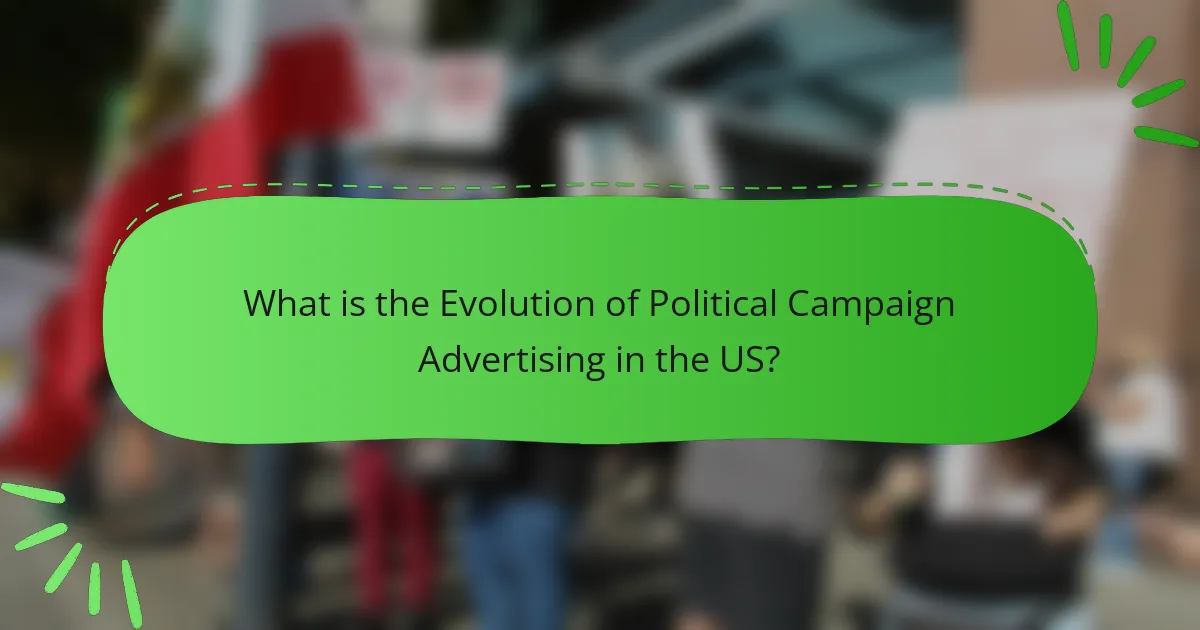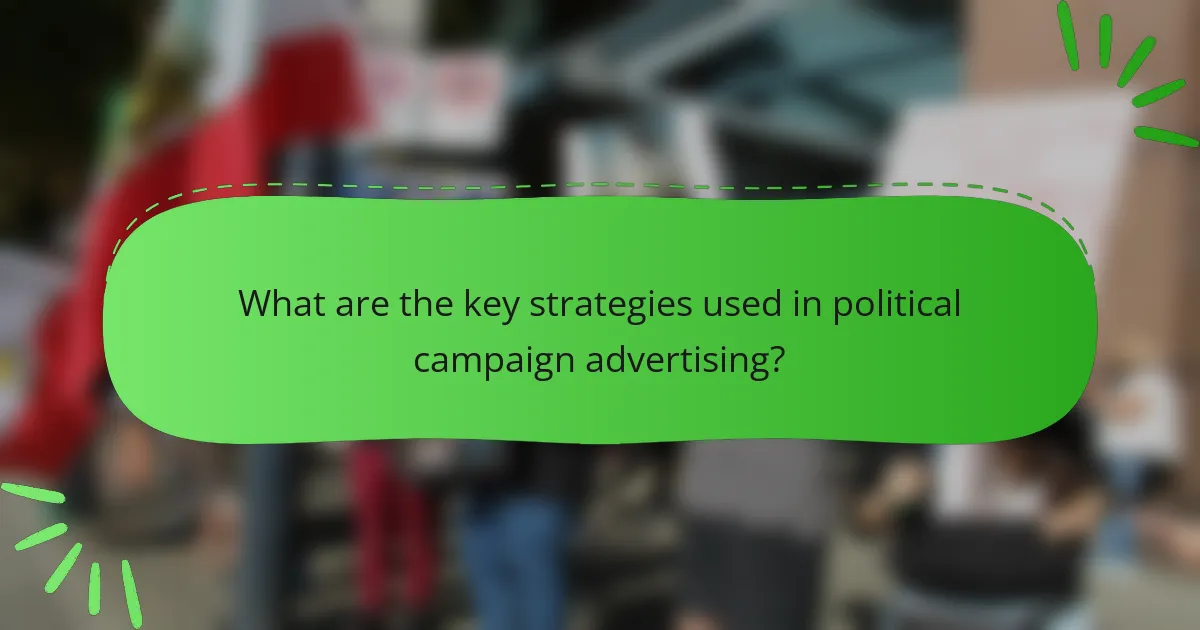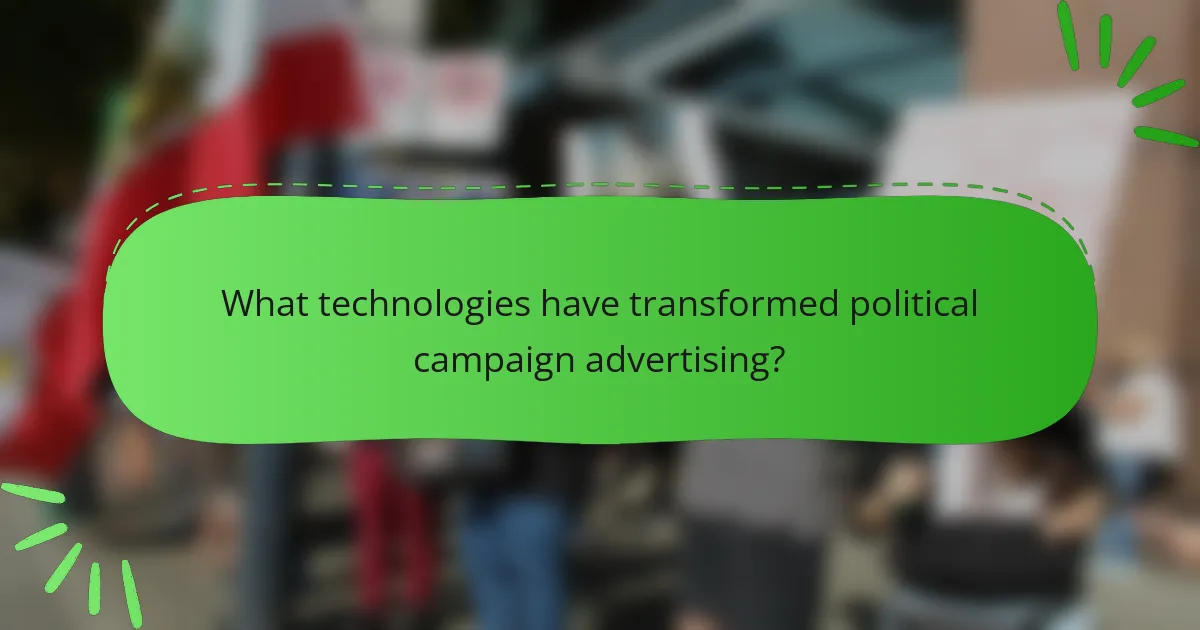The article examines the evolution of political campaign advertising in the United States, highlighting the progression from 19th-century pamphlets and speeches to modern digital strategies. Key phases include the introduction of radio in the 1920s, television in the 1950s, and the rise of the internet in the 1990s, each transforming how candidates engage with voters. The article discusses effective strategies such as demographic targeting, social media utilization, and persuasive messaging, emphasizing the role of data analytics and micro-targeting in contemporary campaigns. It also addresses the significant impact of digital advertising technologies, including programmatic advertising, on voter mobilization and engagement in recent elections.

What is the Evolution of Political Campaign Advertising in the US?
The evolution of political campaign advertising in the US has progressed through several distinct phases. Initially, political messaging relied on pamphlets and speeches in the 19th century. With the advent of radio in the 1920s, candidates began using this medium to reach broader audiences. Television emerged in the 1950s, revolutionizing campaign strategies with visual storytelling. The 1980s saw the introduction of direct mail campaigns, targeting specific voter demographics. The rise of the internet in the 1990s allowed for digital advertising and social media engagement. Today, data analytics and micro-targeting play crucial roles in campaign strategies. Each phase reflects advancements in technology and shifts in voter engagement methods.
How has political campaign advertising changed over the decades?
Political campaign advertising has evolved significantly over the decades. In the early 20th century, campaigns relied heavily on print media and posters. Radio emerged in the 1920s, allowing candidates to reach broader audiences. The introduction of television in the 1950s transformed political advertising with visual storytelling. Campaigns began utilizing sound bites and imagery to connect with voters emotionally. The rise of cable television in the 1980s allowed for targeted advertising to specific demographics. The internet revolutionized political advertising in the 2000s, enabling online ads and social media engagement. Today, data analytics and micro-targeting are essential for precision in reaching voters. This shift reflects advancements in technology and changes in voter behavior.
What were the key milestones in the history of political campaign advertising?
The key milestones in the history of political campaign advertising include the introduction of print media in the 1800s. Newspapers became vital for political communication. The 1920 presidential election marked the first use of radio for political ads. This allowed candidates to reach a broader audience. In the 1950s, television emerged as a dominant medium for campaign advertising. The 1960 Kennedy-Nixon debate showcased the power of visual media. The 1980s saw the rise of direct mail campaigns, targeting specific voter demographics. The internet revolutionized political advertising in the 2000s with online ads and social media. Recent elections have utilized data analytics for targeted advertising, enhancing campaign strategies.
How did historical events shape advertising strategies?
Historical events significantly influenced advertising strategies. For instance, World War II led to the use of propaganda techniques in advertising. Advertisers adopted emotional appeals to boost morale and support for the war. The post-war economic boom shifted focus to consumerism, prompting brands to emphasize lifestyle and aspiration. The civil rights movement in the 1960s introduced social responsibility into advertising, as brands began to align with social causes. Technological advancements, such as television and the internet, revolutionized advertising reach and targeting. Each historical event necessitated adaptations in messaging and channels to effectively connect with audiences.
Why is understanding the evolution of political campaign advertising important?
Understanding the evolution of political campaign advertising is important because it reveals how strategies and technologies have shaped political communication. Over time, advertising has transitioned from print media to digital platforms. Each shift reflects changes in voter behavior and media consumption. For example, television became a dominant medium in the 1960s, significantly influencing public perception. In recent years, social media has transformed how campaigns target and engage voters. Analyzing these changes helps political strategists develop effective messaging. It also aids historians and analysts in understanding electoral outcomes. Overall, this knowledge is crucial for adapting to future political landscapes.
What impact does advertising have on voter behavior?
Advertising significantly influences voter behavior. It shapes perceptions of candidates and issues. Research indicates that exposure to political ads can increase voter turnout. A study by the Pew Research Center found that 60% of voters were influenced by campaign ads. Ads often highlight key issues, swaying opinions and priorities. Emotional appeals in advertising can create strong connections with voters. For instance, negative ads can lead to decreased support for opponents. Overall, advertising plays a crucial role in informing and mobilizing voters.
How does the evolution of advertising reflect changes in society?
The evolution of advertising reflects changes in society by adapting to cultural values and technological advancements. Historically, advertisements mirrored societal norms, such as the shift from traditional gender roles in the 1950s to more diverse representations today. The introduction of television transformed advertising, making it a central part of American culture. In the digital age, social media platforms have revolutionized targeting and engagement, reflecting the importance of connectivity. Data from the Pew Research Center shows that 72% of adults use social media, highlighting its impact on advertising strategies. Additionally, the rise of consumer activism has led brands to focus on social responsibility in their messaging. This evolution illustrates how advertising not only responds to but also influences societal trends and behaviors.

What are the key strategies used in political campaign advertising?
Key strategies used in political campaign advertising include targeting specific demographics, utilizing social media platforms, and employing persuasive messaging. Targeting specific demographics allows campaigns to tailor their messages to resonate with particular voter groups. Social media platforms enable campaigns to reach a broad audience quickly and cost-effectively. Persuasive messaging focuses on emotional appeals and key issues that matter to voters.
According to a Pew Research study, 69% of U.S. adults use social media, highlighting its importance in modern campaigns. Additionally, targeted advertising can increase engagement rates significantly, as seen in the 2012 Obama campaign, which effectively used data analytics to reach specific voter segments. These strategies collectively enhance the effectiveness of political campaign advertising.
How do candidates decide on their advertising strategies?
Candidates decide on their advertising strategies based on target audience analysis and campaign goals. They assess demographic data to identify key voter segments. Candidates also evaluate their opponents’ strategies to differentiate their messaging. Budget constraints significantly influence advertising choices, determining the platforms and formats used. Historical performance data from past campaigns informs decisions on effective tactics. Additionally, candidates consider current events and social issues to ensure relevance. Media trends and technological advancements shape the channels selected for outreach. Research indicates that tailored messaging increases voter engagement, making it a priority in strategy development.
What factors influence the choice of advertising channels?
The choice of advertising channels is influenced by target audience demographics, budget constraints, and campaign objectives. Understanding the target audience helps identify where they consume media. For example, younger audiences may prefer social media platforms, while older demographics might respond better to traditional media. Budget constraints dictate the feasibility of using certain channels. High-cost channels may be limited to campaigns with larger budgets. Campaign objectives also play a crucial role; a brand awareness campaign might utilize broader channels, while a targeted outreach might focus on niche platforms. According to the Pew Research Center, 81% of Americans use social media, highlighting its significance in modern advertising strategies.
How do campaign goals shape advertising strategies?
Campaign goals directly influence advertising strategies by determining the focus and messaging of the campaigns. Specific goals, such as increasing voter turnout or building brand awareness, shape the type of content created. For instance, a campaign aiming to mobilize young voters may use social media platforms heavily. This aligns with data showing that 71% of young people engage with political content on social media. Additionally, campaign goals dictate budget allocation, targeting methods, and media channels. A goal of reaching undecided voters may lead to targeted ads in swing states. Historical examples, like the Obama campaign in 2008, illustrate how clear goals can lead to innovative strategies, leveraging digital platforms effectively. Thus, campaign goals play a crucial role in shaping the overall advertising approach.
What role do demographics play in political campaign advertising strategies?
Demographics play a crucial role in political campaign advertising strategies. Campaigns analyze demographic data to target specific voter segments effectively. This includes age, gender, income, education, and ethnicity. For example, younger voters may respond better to social media ads, while older voters might prefer traditional media. Tailoring messages to resonate with particular demographics enhances engagement. According to a study by the Pew Research Center, targeted advertising can increase voter turnout by 10-15% in specific demographic groups. Thus, understanding demographics allows campaigns to allocate resources efficiently and maximize impact.
How do campaigns target specific voter groups?
Campaigns target specific voter groups through data analysis and tailored messaging. They utilize voter demographic information to identify key characteristics of different groups. This includes age, gender, income, and education level. Campaigns then create messaging that resonates with these specific attributes. For example, younger voters may receive content focused on climate change. In contrast, older voters might see messages about healthcare. Social media platforms enable targeted advertisements based on user data. Research shows that personalized outreach increases voter engagement. A study by the Pew Research Center indicates that targeted ads can significantly influence voter behavior.
What demographic trends have emerged in recent elections?
Recent elections have shown significant demographic trends, particularly among younger voters and minority groups. Younger voters, especially those aged 18 to 29, have increasingly participated in elections. For example, their turnout rose to 50% in the 2020 election, up from 36% in 2016. Minority groups, including Black and Hispanic voters, also demonstrated higher engagement. In 2020, Black voter turnout reached 63%, an increase from 59% in 2016. Additionally, Hispanic voters showed a notable increase, with 50% participating in the 2020 election compared to 47% in 2016. These trends indicate a shifting electorate that may influence future political strategies and advertising approaches.

What technologies have transformed political campaign advertising?
Digital advertising has transformed political campaign advertising significantly. Technologies such as social media platforms, data analytics, and programmatic advertising have reshaped how campaigns reach voters. Social media allows for targeted messaging to specific demographics. Platforms like Facebook and Twitter enable real-time engagement with constituents. Data analytics provides insights into voter behavior and preferences. Campaigns can now tailor their messages based on this data. Programmatic advertising automates the buying of ad space, increasing efficiency. These technologies have led to more personalized and effective campaign strategies. The impact of these advancements is evident in recent elections, where digital strategies played a crucial role in voter mobilization.
How has digital technology changed the landscape of political advertising?
Digital technology has significantly transformed political advertising. It has enabled targeted advertising through data analytics. Campaigns can now reach specific demographics based on online behavior. Social media platforms allow for real-time engagement with voters. This shift has increased the speed and volume of political messaging. In 2020, over 60% of political ad spending was digital, according to the Advertising Research Foundation. Digital tools facilitate grassroots fundraising and mobilization efforts. The use of video content has also surged, appealing to younger audiences. Overall, digital technology has made political advertising more precise and interactive.
What are the most effective digital platforms for political advertising?
The most effective digital platforms for political advertising are Facebook, Google, Twitter, and Instagram. Facebook offers targeted advertising capabilities with a vast user base. According to a Pew Research study, 69% of adults in the U.S. use Facebook, making it a key platform for reaching voters. Google Ads allows campaigns to target specific demographics and keywords, enhancing visibility. Twitter engages users in real-time, facilitating direct communication with constituents. Instagram’s visually driven content appeals to younger audiences, effectively spreading campaign messages. Each platform provides unique tools for analytics and audience engagement, optimizing political outreach.
How do data analytics enhance campaign advertising efforts?
Data analytics enhance campaign advertising efforts by providing insights into voter behavior and preferences. These insights allow campaigns to target specific demographics effectively. Analytics can track engagement metrics across various platforms. This data helps in optimizing ad content and placement for better performance. For instance, campaigns can analyze which messages resonate most with voters. They can adjust strategies based on real-time feedback. According to a study by the Pew Research Center, targeted ads increase engagement rates by up to 50%. This demonstrates the effectiveness of data-driven decision-making in political advertising.
What traditional advertising methods are still relevant today?
Traditional advertising methods that are still relevant today include television advertising, radio spots, print media, and direct mail campaigns. Television advertising remains influential, with 90% of U.S. households having a TV, making it a key medium for reaching voters. Radio spots continue to engage audiences, particularly in local markets, with 82% of Americans listening to radio weekly. Print media, including newspapers and magazines, still hold value, especially for targeting specific demographics. Direct mail campaigns are effective, with 70% of consumers reporting they prefer receiving promotional materials via mail. These methods have adapted to modern technologies while retaining their core effectiveness in political campaign advertising.
How do print and broadcast media compare to digital methods in effectiveness?
Print and broadcast media are generally less effective than digital methods in reaching and engaging audiences. Digital methods allow for targeted advertising based on user data and preferences. According to a 2022 study by the Pew Research Center, 53% of adults in the U.S. get their news from social media. This contrasts with only 16% relying on print newspapers. Additionally, digital platforms enable real-time feedback and interaction, enhancing voter engagement. In comparison, print and broadcast media lack this immediacy and interactivity. Thus, digital methods provide a more effective approach for political campaign advertising.
What are the advantages of using traditional media in campaigns?
Traditional media offers several advantages in campaigns. It provides broad reach, allowing advertisers to connect with large audiences effectively. Traditional media includes television, radio, newspapers, and magazines. These platforms often have established trust with their audiences. For instance, a 2020 Nielsen report noted that 92% of consumers trust recommendations from traditional media. Additionally, traditional media can enhance brand recognition through repetitive exposure. Campaigns that utilize television ads can achieve significant visibility, as the average American watches around 4 hours of TV daily. Furthermore, traditional media allows for targeted messaging based on demographics and geographic locations. This targeted approach can lead to higher engagement rates and conversion. Overall, traditional media remains a powerful tool in campaign strategies.
What best practices should campaigns follow in their advertising efforts?
Campaigns should follow several best practices in their advertising efforts. First, they must define clear objectives. Objectives guide the campaign’s direction and measure success. Second, understanding the target audience is crucial. Researching demographics and preferences ensures messages resonate. Third, consistency in messaging across all platforms strengthens brand recognition. Uniformity builds trust and familiarity with voters. Fourth, utilizing data analytics allows campaigns to refine strategies. Analytics provide insights into voter behavior and ad performance. Fifth, engaging storytelling captures attention and evokes emotions. Stories make messages relatable and memorable. Lastly, monitoring and adapting campaigns in real-time is essential. Flexibility allows campaigns to respond to changing dynamics effectively. These practices enhance the effectiveness of political advertising efforts.
How can campaigns measure the effectiveness of their advertising strategies?
Campaigns can measure the effectiveness of their advertising strategies through various metrics and analysis methods. Key performance indicators (KPIs) such as reach, engagement, and conversion rates provide quantifiable data. Surveys can assess voter awareness and sentiment before and after campaigns. A/B testing allows campaigns to compare different ad versions for performance. Additionally, tracking website traffic and social media interactions offers insights into audience response. Data analytics tools can aggregate and analyze this information for comprehensive evaluation. According to a study by the Pew Research Center, 55% of voters reported that social media influenced their voting decisions, highlighting the importance of measuring digital ad effectiveness.
What common pitfalls should campaigns avoid in political advertising?
Campaigns should avoid misleading information in political advertising. Misleading claims can damage credibility and trust. Voters are likely to respond negatively to false statements. Additionally, campaigns should steer clear of negative ads that focus solely on attacking opponents. Such tactics can alienate potential supporters. Failing to target the right audience is another common pitfall. Campaigns must ensure their messages reach the intended demographic. Lastly, neglecting to adapt to new technologies can hinder effectiveness. Campaigns should embrace digital platforms to engage voters effectively.
The main entity of the article is the evolution of political campaign advertising in the US. This article outlines the historical progression of campaign advertising methods, from 19th-century pamphlets to modern digital strategies, highlighting key milestones and technological advancements. It discusses how advertising strategies have adapted over the decades, the impact of demographics and historical events on messaging, and the importance of data analytics in targeting voters. Additionally, the article examines both traditional and digital advertising methods, their effectiveness, and best practices for successful campaign strategies.